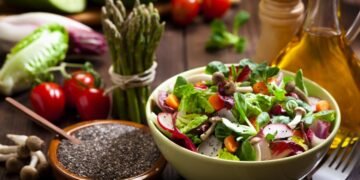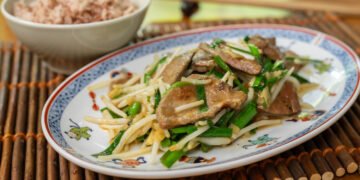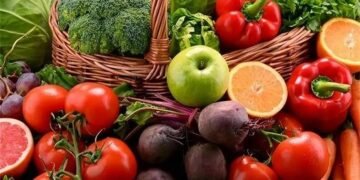Magnesium is an important mineral with multiple positive effects on human health. Magnesium is involved in over 300 enzymatic reactions and is crucial for nerve conduction, muscle function, cardiovascular health, and energy metabolism. Magnesium plays a particularly significant role in relaxing the body and mind and improving sleep quality. This article will explore the importance of magnesium and provide comprehensive guidelines for a healthy lifestyle, including balanced diet, nutritional supplementation, weight management, and disease prevention. We will provide a healthy diet guide, in-depth analysis of nutritious foods, the latest research in nutrition, and food safety information, and share several recipes that can help improve energy and vitality. Finally, we will provide a guide from the field to the dining table to help readers make more environmentally friendly and healthy food choices.
The Importance of Magnesium
1. Neuroconduction: Magnesium helps maintain normal nervous system function, reduce anxiety and tension, and promote relaxation.
2. Muscle function: Magnesium participates in muscle contraction and relaxation, helping to alleviate muscle pain and spasms.
3. Cardiovascular Health: Magnesium helps maintain normal heart rhythm and blood pressure, reducing the risk of cardiovascular disease.
4. Energy metabolism: Magnesium participates in energy metabolism processes and supports cellular energy production.
5. Sleep Quality: Magnesium helps regulate the secretion of melatonin, improving sleep quality and depth.
Food sources of magnesium
1. Plant based source:
Green leafy vegetables: Spinach, kale, beetroot leaves and other green leafy vegetables are rich in magnesium.
Nuts and seeds: Pumpkin seeds, almonds, Brazil nuts, sesame seeds, and other nuts and seeds are rich in magnesium.
Beans: Beans such as black beans, red beans, and beans are good sources of magnesium.
Whole grains: Oats, brown rice, quinoa, and other whole grains contain magnesium.
Fruits: Avocados, bananas, figs, and other fruits contain magnesium.
2. Animal origin:
Seafood: Shellfish (such as oysters) and fish (such as salmon) are rich in magnesium.
Dairy products: Yogurt, cheese, and other dairy products contain magnesium.
The contribution of a healthy lifestyle
1. Balanced diet: A balanced diet is the cornerstone of a healthy lifestyle, including sufficient protein, complex carbohydrates, healthy fats, fiber, vitamins, and minerals. Whole foods, organic ingredients, and plant-based foods are key to achieving this goal.
2. Nutritional supplementation: For certain populations, such as those under high stress, poor sleep quality, or imbalanced diet, it is necessary to supplement magnesium appropriately. Suggest supplementing under the guidance of a doctor.
3. Weight management: Healthy eating habits can help control weight and reduce the risk of obesity and related diseases, such as cardiovascular disease and type 2 diabetes.
4. Disease prevention: Antioxidants and anti-inflammatory ingredients in a balanced diet can reduce the risk of chronic diseases, such as cardiovascular disease, type 2 diabetes and some cancers.
Healthy Eating Guide
1. Choose whole foods: Whole foods refer to unprocessed or minimally processed foods such as whole grains, beans, nuts, seeds, vegetables, and fruits. These foods retain more nutrients and fiber, which helps maintain health.
2. Organic Ingredients: Prioritize organic certified ingredients to ensure they are free of chemical pesticides and fertilizer residues, making them safer and healthier. Organic agriculture follows natural laws and helps protect the environment.
3. Plant based foods: Plant based foods are rich in fiber, vitamins, minerals, and antioxidants, which help improve energy and vitality and prevent diseases. For example, legumes, whole grains, and vegetables are all high-quality plant-based ingredients.
4. Seasonal Ingredients: Choosing organic ingredients of the season not only offers more affordable prices but also higher nutritional value. Understand the seasonal ingredients of different seasons and develop corresponding recipes. For example, strawberries, spinach, and asparagus can be chosen in spring, while summer is the harvest season for tomatoes, cucumbers, and watermelons.
Healthy recipe sharing
1. Magnesium rich breakfast: avocado banana milkshake
Ingredients: 1 organic avocado, 1 organic banana, 1 cup of organic almond milk, 1 tablespoon of organic chia seeds, 1 teaspoon of organic honey (optional)
Preparation method: Put all the ingredients into a blender, stir evenly, and then drink.
2. Magnesium rich lunch: Quinoa and Lentil Salad
Ingredients: 1 cup organic quinoa, 1 cup organic lentil, 1 organic red pepper, 1 organic cucumber, 1 organic tomato, 1 tablespoon olive oil, 1 tablespoon lemon juice, 1 teaspoon honey, 1 teaspoon mustard sauce, a little salt and black pepper
Preparation method: Boil quinoa and beans, cool and set aside. Cut red pepper, cucumber, and tomato into cubes. Put all the ingredients into a large bowl, mix olive oil, lemon juice, honey, mustard, salt and black pepper, pour on the salad, and mix well.
3. Magnesium rich dinner: roasted chicken with pumpkin seeds
Ingredients: 1 organic chicken breast, 1/4 cup organic pumpkin seeds, 1 tablespoon olive oil, 1 teaspoon ginger, 1 teaspoon garlic, 1 teaspoon rosemary, 1 teaspoon thyme, a pinch of salt and black pepper
Method: Marinate chicken breast with olive oil, ginger, garlic, rosemary, thyme, salt, and black pepper for 10 minutes. Stir fry pumpkin seeds until fragrant and set aside for later use. Put the marinated chicken breast into a baking tray, sprinkle with stir fried pumpkin seeds, preheat the oven to 180 ° C, bake for 20 minutes until the chicken breast is fully cooked. Take out the slices and they are ready to eat.
4. Magnesium rich energy snack: a mixture of nuts and seeds
Ingredients: 1/2 cup of organic almonds, 1/2 cup of organic walnuts, 1/4 cup of organic pumpkin seeds, 1/4 cup of organic sunflower seeds, 1 tablespoon of organic coconut shreds, 1 teaspoon of sea salt
Preparation method: Mix all the ingredients evenly, put them in the oven at 150 ° C for 15 minutes, take them out and let them cool, put them in a sealed container, and carry them with you as an energy snack.
A guide from the fields to the dining table
1. Choose organic ingredients: Prioritize organic certified ingredients to ensure they are free of chemical pesticides and fertilizer residues, making them safer and healthier. Organic agriculture follows natural laws and helps protect the environment.
2. Local procurement: Purchase locally produced organic ingredients that are not only fresh, but also reduce carbon emissions during transportation, supporting local agriculture. By participating in local farmers’ markets or joining Community Supported Agriculture (CSA) programs, one can directly interact with farmers and learn about the sources of ingredients.
3. Seasonal Ingredients: Choosing organic ingredients of the season not only offers more affordable prices but also higher nutritional value. Understand the seasonal ingredients of different seasons and develop corresponding recipes. For example, strawberries, spinach, and asparagus can be chosen in spring, while summer is the harvest season for tomatoes, cucumbers, and watermelons.
4. Sustainable Procurement: Support sustainable agriculture and fair trade, choose brands and producers that prioritize environmental protection and social responsibility. Check the packaging and labels of the product to understand its production process and environmental protection measures.
5. Reduce waste: Plan your diet reasonably and avoid excessive purchases and food waste. The remaining ingredients can be made into soup or stew, fully utilizing each part. Pay attention to freshness when storing food and extend the shelf life of ingredients.
Conclusion
By understanding the importance of magnesium and its food sources, we can better consume this important mineral in our daily diet, relax our body and mind, and improve sleep quality. From the fields to the dining table, every step reflects care for health and the environment, allowing us to move towards a better life together. By practicing these principles of healthy eating, we can create a healthier and greener eating environment for ourselves and our families. Whether it’s breakfast, energy snacks, or healthy dinners, choosing whole foods, organic ingredients, and plant-based foods can make our lives more colorful.











































